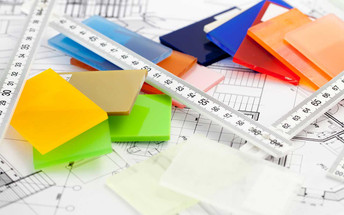FAQ Plastic Used in Specific Applications
What plastic is approved for food processing?
Many plastics are FDA grade, meaning they can be used in food handling and processing applications. Virgin polyolefins like HDPE, LDPE, polypropylene and UHMW include FDA grades. There are food grades of Nylon and Acetal; however, these materials are subject to degradation due to chemical washdowns. PET is also approved and commonly used in food contact applications.
What types of plastic are used in airplanes?
For a material to be approved for use in aerospace applications, it must be tested against and meet FAA and industry regulations for flame, smoke, toxicity and performance when exposed to temperature, pressure and chemicals. Polycarbonate, PVC/acrylic polymer blends, acrylic, phenolic, PTFE and PEEK are just a few thermoplastics commonly utilized for aerospace applications.
What are aquariums made out of?
The two most common materials for aquarium construction are cast acrylic and glass. Cast acrylic, while typically more expensive than glass, is lighter in weight and more impact resistant than glass. Aquarium manufacturers prefer cast acrylic because it can be more easily formed into shapes. PVC is commonly used for aquarium bottoms.
What thickness of acrylic do I need for my aquarium?
Thickness of the acrylic depends on the size of the aquarium being made, as well as the method of construction. An aquarium thickness calculator should be used. In general, in water applications which expose acrylic to continuous stress, 750 psi the maximum stress recommended.
What plastic is best to protect my windows during a storm?
Hurricane storm panels made of polycarbonate, as well as multi-wall polycarbonate, are the most cost-effective protection. They can be stored conveniently and don’t require a lot of space when not being used. There are versions that meet stringent building and insurance codes in geographical areas prone to hurricanes.
What is the best material to protect my storefront from storms, vandalism and riots?
Polycarbonate is virtually unbreakable and used to protect business storefronts and windows from possible debris caused by storms, vandalism and riots. Clear polycarbonate panels will not crack when impact an object such as a branch, brick or bat. Polycarbonate is lighter and stronger than plywood.
What material should be used for outdoor furniture?
UV stabilized materials like high density polyethylene (HDPE) and acrylic are the most common. HDPE is very strong and weather resistant. Unlike wood, it will not absorb water which leads to rotting and delamination. Acrylic is used for table tops for patio furniture due to its excellent UV properties.
What plastic is used in 3D printers?
The most common plastic filaments used in 3D printers are ABS and PLA thermoplastics and both are similar in cost. ABS offers better mechanical properties while PLA is better in design application where finished appearance is vital.
What are football helmets made out of?
The exterior shell of a standard American football helmet is made from injection-molded polycarbonate. The polycarbonate shell is lightweight and impact resistant. The interior padding is commonly polyurethane foam wrapped in a vinyl casing. Clear plastic visors are typically made from polycarbonate.
What material is used for drum shields?
The two most common materials used to make panels on a transparent drum shield are acrylic and polycarbonate. Acrylic is typically less expensive, more scratch resistant, offers better transparency and a better gloss finish. Polycarbonate is virtually unbreakable and more common if the drum shield is being handled often. The panels are typically connected with a living or piano hinge.
What is outdoor composite decking made out of?
Composite lumber is commonly comprised of recycled wood and plastic. From wood, it can come from saw dust, chips and other scrap. Post-consumer recycled plastic products, such as bottles and grocery bags, can be used in composite products.
What plastic is used for golf cart windshields?
The most common material used for golf cart windshields is impact modified acrylic. The material offers a high level of light transmission, impact resistance and formability. For enclosed golf carts, acrylic is also UV resistance with standard grades blocking approximately 93% of UV rays. Polycarbonate and hard-coated polycarbonate are also used.
What material can be used as a protective bed liner?
UHMW liners are available through Quadrant, Polymer Ind and Rochling. Most of these manufacturers have their own brand, like Quick Silver, and also have their own divisions that will take business direct, so be careful. Disposable liners for dirt hauling can be PE, usually at least 6 mil thick. Urethane spray coats are available as well.
What material can replace plywood on my boat?
HDPE, PVC and expanded PVC have been utilized as plywood substitutes in boat construction and repair applications. HDPE in particular is ideal because it will not absorb water and can be infused with UV inhibitors. HDPE is commonly used instead of (or to replace) teak on boats.
What material is used to make dry erase boards?
The most common and inexpensive material is melamine, which is laminated to a wood substrate. Melamine is prone to ghosting and degrades quickly. Other dry erase boards are made from coated acrylic, porcelain, glass and metal.
Where I can get a replacement windshield for my boat?
Contact a local plastic distributor and fabricator with the windshield specifications. They can replicate the design, including bends and curves, of an existing boat windshield and provide a ready-to-install piece. Plastic distributors typically have the material on hand with machining capabilities to handle spot orders.
What does that triangle symbol on the bottom of a plastic milk jug or detergent container stand for?
It is a RIC (resin identification code) numbered 1-7 and each number has a specific category of plastic for recycling purposes. For example, 1 is for PET, used to make bottles and containers for soft drinks, beer, mouthwash, peanut butter, etc.

